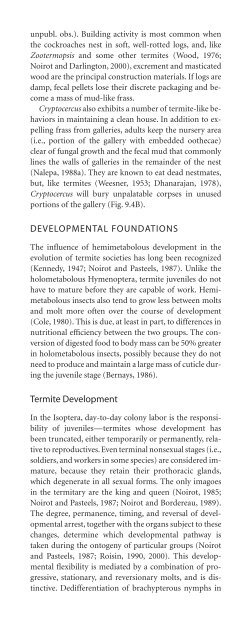Cockroache; Ecology, behavior & history - W.J. Bell
Cockroache; Ecology, behavior & history - W.J. Bell
Cockroache; Ecology, behavior & history - W.J. Bell
Create successful ePaper yourself
Turn your PDF publications into a flip-book with our unique Google optimized e-Paper software.
unpubl. obs.). Building activity is most common when<br />
the cockroaches nest in soft, well-rotted logs, and, like<br />
Zootermopsis and some other termites (Wood, 1976;<br />
Noirot and Darlington, 2000), excrement and masticated<br />
wood are the principal construction materials. If logs are<br />
damp, fecal pellets lose their discrete packaging and become<br />
a mass of mud-like frass.<br />
Cryptocercus also exhibits a number of termite-like <strong>behavior</strong>s<br />
in maintaining a clean house. In addition to expelling<br />
frass from galleries, adults keep the nursery area<br />
(i.e., portion of the gallery with embedded oothecae)<br />
clear of fungal growth and the fecal mud that commonly<br />
lines the walls of galleries in the remainder of the nest<br />
(Nalepa, 1988a). They are known to eat dead nestmates,<br />
but, like termites (Weesner, 1953; Dhanarajan, 1978),<br />
Cryptocercus will bury unpalatable corpses in unused<br />
portions of the gallery (Fig. 9.4B).<br />
DEVELOPMENTAL FOUNDATIONS<br />
The influence of hemimetabolous development in the<br />
evolution of termite societies has long been recognized<br />
(Kennedy, 1947; Noirot and Pasteels, 1987). Unlike the<br />
holometabolous Hymenoptera, termite juveniles do not<br />
have to mature before they are capable of work. Hemimetabolous<br />
insects also tend to grow less between molts<br />
and molt more often over the course of development<br />
(Cole, 1980). This is due, at least in part, to differences in<br />
nutritional efficiency between the two groups. The conversion<br />
of digested food to body mass can be 50% greater<br />
in holometabolous insects, possibly because they do not<br />
need to produce and maintain a large mass of cuticle during<br />
the juvenile stage (Bernays, 1986).<br />
Termite Development<br />
In the Isoptera, day-to-day colony labor is the responsibility<br />
of juveniles—termites whose development has<br />
been truncated, either temporarily or permanently, relative<br />
to reproductives. Even terminal nonsexual stages (i.e.,<br />
soldiers, and workers in some species) are considered immature,<br />
because they retain their prothoracic glands,<br />
which degenerate in all sexual forms. The only imagoes<br />
in the termitary are the king and queen (Noirot, 1985;<br />
Noirot and Pasteels, 1987; Noirot and Bordereau, 1989).<br />
The degree, permanence, timing, and reversal of developmental<br />
arrest, together with the organs subject to these<br />
changes, determine which developmental pathway is<br />
taken during the ontogeny of particular groups (Noirot<br />
and Pasteels, 1987; Roisin, 1990, 2000). This developmental<br />
flexibility is mediated by a combination of progressive,<br />
stationary, and reversionary molts, and is distinctive.<br />
Dedifferentiation of brachypterous nymphs in<br />
termites is the only known instance of a natural reversal<br />
of metamorphosis in insects (Nijhout and Wheeler,<br />
1982). The extraordinary complexity and sophistication<br />
characteristic of termite development is nonetheless<br />
rooted in mechanisms of postembryonic development<br />
observed in non-eusocial insects (Bordereau, 1985). The<br />
developmental characteristics of cockroach ancestors,<br />
then, were the phylogenetic foundation on which termite<br />
polyphenisms were built.<br />
Cockroach Development<br />
Within a cockroach species, both the number and duration<br />
of instars that precede the metamorphic molt are<br />
variable, a trait unusual among hexapods (Heming,<br />
2003). In P. americana, for example, the length of<br />
nymphal period can vary from 134 to 1031 days (Roth,<br />
1981a)—nearly an order of magnitude. The number of<br />
molts in cockroaches varies from 5 or 6 to 12 or 13, and<br />
may or may not vary between the sexes. Within a species,<br />
variation in cockroach development occurs primarily in<br />
response to environmental conditions: low temperature,<br />
minor injuries, water or food deficits, or poor food quality<br />
(Tanaka, 1981; Mullins and Cochran, 1987). Even in<br />
laboratory cultures in which extrinsic influences have<br />
been minimized or controlled, however, the instar of<br />
metamorphosis remains variable, even in nymphs from<br />
the same ootheca (Kunkel, 1979; Woodhead and Paulson,<br />
1983). There can be a lag of up to 9 mon between the appearance<br />
of the first and last adult among nymphs from<br />
the same sibling cohort of Periplaneta australasiae (Pope,<br />
1953), and “runts”—nymphs stalled in the third or<br />
fourth instar when all others in the cohort have matured—have<br />
been noted in P. americana (Wharton et al.,<br />
1968). Kunkel (1979) describes the instar of metamorphosis<br />
in cockroaches as a polygenic trait with a great<br />
deal of environmental input involved in its expression.<br />
Significantly, there are records of both stationary and<br />
saltatory molts in cockroaches (Gier, 1947; Rugg and<br />
Rose, 1990). If the ancestor of the termites was like extant<br />
cockroaches, then it, too, possessed a tremendous<br />
amount of developmental plasticity prior to evolving eusociality.<br />
Control of Development<br />
An examination of conditions known to modify cockroach<br />
development may provide insight into the origins<br />
of termite polyphenism, the proximate causes of which<br />
are still little understood (Bordereau, 1985; Roisin, 2000).<br />
Here we focus on three extrinsic factors that may have<br />
influenced development as the termite lineage evolved:<br />
minor injuries, nourishment, and group effects. Each of<br />
TERMITES AS SOCIAL COCKROACHES 155


